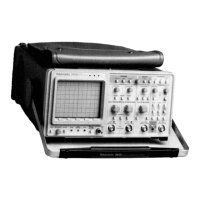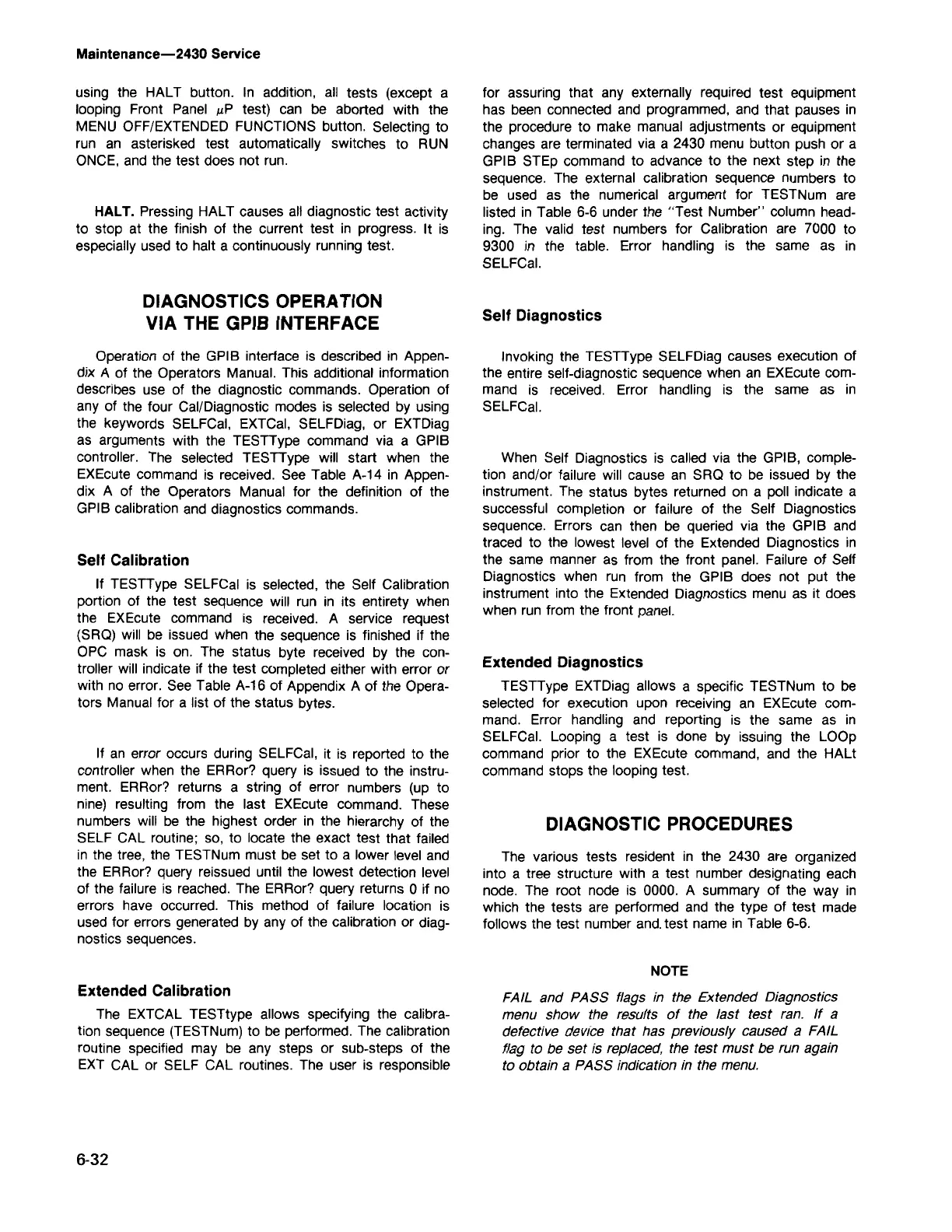FAIL and PASS flags in the Extended Diagnostics
menu show the results of the last test ran. If a
defective device that has previously caused a FAIL
flag to be set is replaced, the test must be run again
to obtain
a
PASS indication in the menu.
NOTE
The various tests resident in the 2430 are organized
into a tree structure with a test number designating each
node. The root node is 0000. A summary of the way in
which the tests are performed and the type of test made
follows the test number and.test name in Table 6-6.
DIAGNOSTIC PROCEDURES
Extended Diagnostics
TESTIype EXTDiag allows a specific TESTNum to be
selected for execution upon receiving an EXEcute com-
mand. Error handling and reporting is the same as in
SELFCal. Looping a test is done by issuing the LOOp
command prior to the EXEcute command, and the HAlt
command stops the looping test.
When Self Diagnostics is called via the GPIB, comple-
tion and/or failure will cause an SRO to be issued by the
instrument. The status bytes returned on a poll indicate a
successful completion or failure of the Self Diagnostics
sequence. Errors can then be queried via the GPIB and
traced to the lowest level of the Extended Diagnostics in
the same manner as from the front panel. Failure of Self
Diagnostics when run from the GPIB does not put the
instrument into the Extended Diagnostics menu as it does
when run from the front panel.
Invoking the TESTIype SELFDiag causes execution of
the entire self-diagnostic sequence when an EXEcute com-
mand is received. Error handling is the same as in
SELFCal.
Self Diagnostics
for assuring that any externally required test equipment
has been connected and programmed, and that pauses in
the procedure to make manual adjustments or equipment
changes are terminated via a 2430 menu button push or a
GPIB STEp command to advance to the next step in the
sequence. The external calibration sequence numbers to
be used as the numerical argument for TESTNum are
listed in Table 6-6 under the "Test Number" column head-
ing. The valid test numbers for Calibration are 7000 to
9300 in the table. Error handling is the same as in
SELFCal.
6-32
Extended Calibration
The EXTCAL TESTtype allows specifying the calibra-
tion sequence (TESTNum) to be performed. The calibration
routine specified may be any steps or sub-steps of the
EXT CAL or SELF CAL routines. The user is responsible
If an error occurs during SELFCal, it is reported to the
controller when the ERRor? query is issued to the instru-
ment. ERRor? returns a string of error numbers (up to
nine) resulting from the last EXEcute command. These
numbers will be the highest order in the hierarchy of the
SELF CAL routine; so, to locate the exact test that failed
in the tree, the TESTNum must be set to a lower level and
the ERRor? query reissued until the lowest detection level
of the failure is reached. The ERRor? query returns 0 if no
errors have occurred. This method of failure location is
used for errors generated by any of the calibration or diag-
nostics sequences.
Self Calibration
If TESTIype SELFCal is selected, the Self Calibration
portion of the test sequence will run in its entirety when
the EXEcute command is received. A service request
(SRO) will be issued when the sequence is finished if the
OPC mask is on. The status byte received by the con-
troller will indicate if the test completed either with error or
with no error. See Table A-16 of Appendix A of the Opera-
tors Manual for a list of the status bytes.
Operation of the GPIB interface is described in Appen-
dix A of the Operators Manual. This additional information
describes use of the diagnostic commands. Operation of
any of the four Cal/Diagnostic modes is selected by using
the keywords SELFCal, EXTCal, SELFDiag, or EXTDiag
as arguments with the TESTType command via a GPIB
controller. The selected TESTType will start when the
EXEcute command is received. See Table A-14 in Appen-
dix A of the Operators Manual for the definition of the
GPIB calibration and diagnostics commands.
DIAGNOSTICS OPERATION
VIA THE GPIB INTERFACE
HALT. Pressing HALT causes all diagnostic test activity
to stop at the finish of the current test in progress. It is
especially used to halt a continuously running test.
using the HALT button. In addition, all tests (except a
looping Front Panel ILP test) can be aborted with the
MENU OFF/EXTENDED FUNCTIONS button. Selecting to
run an asterisked test automatically switches to RUN
ONCE, and the test does not run.
Maintenance-2430 Service

